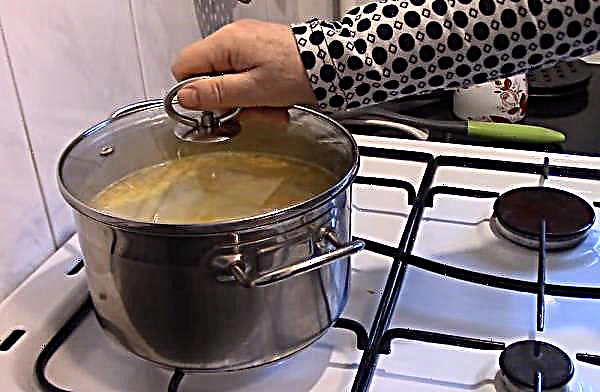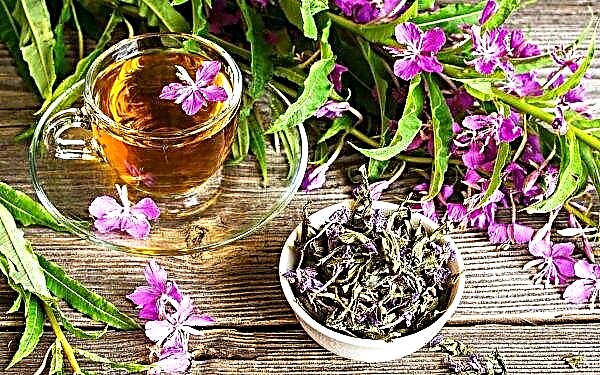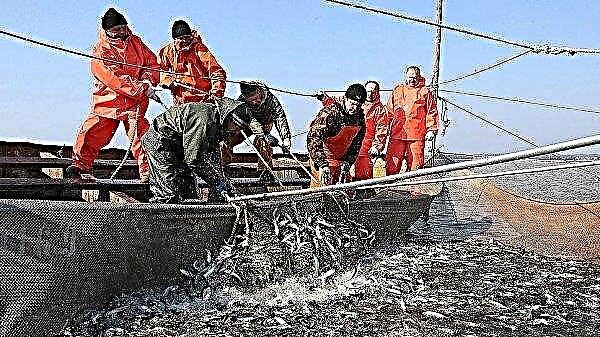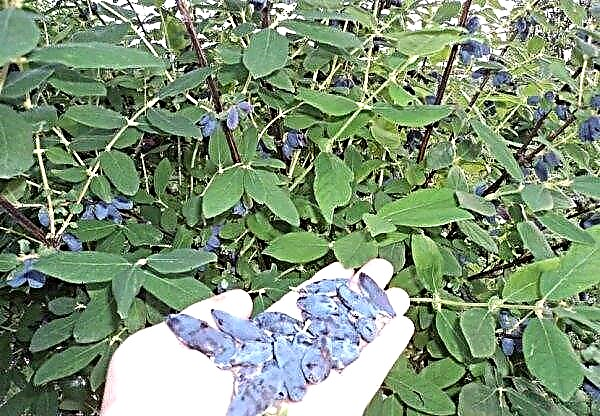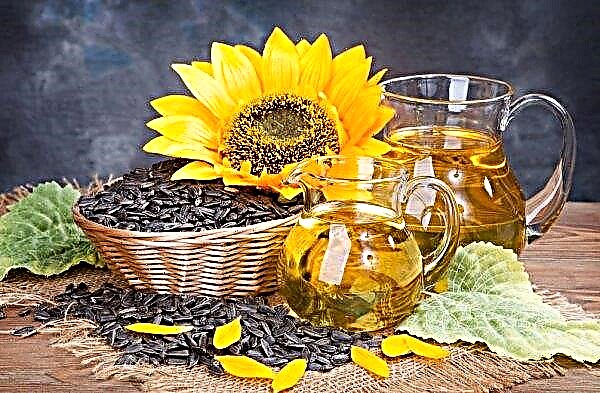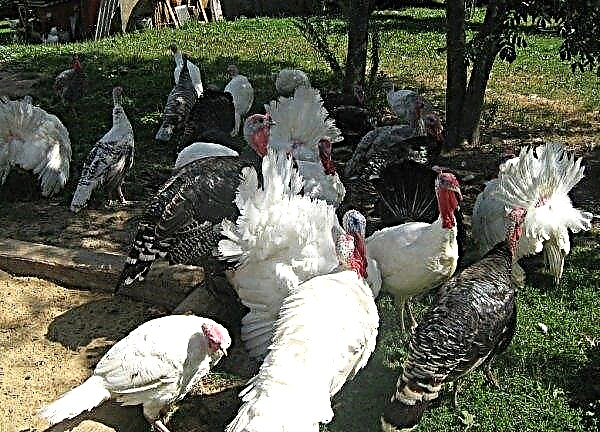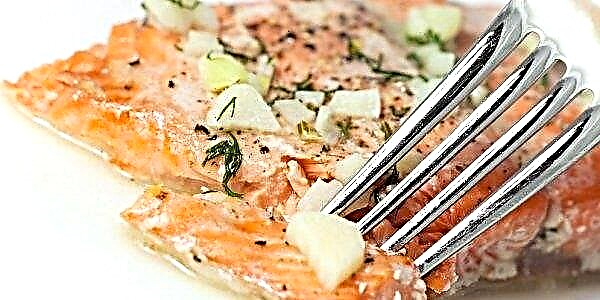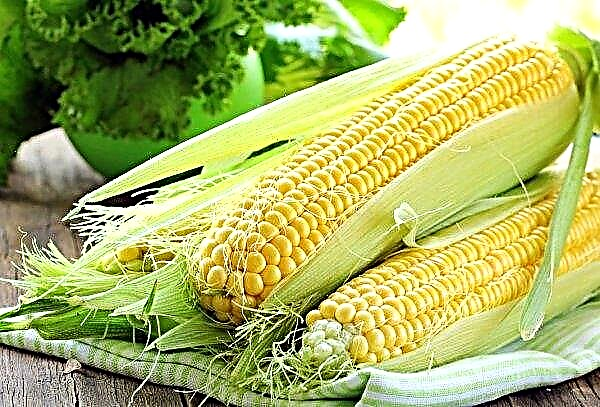Breeding pigeons for meat can be a good source of income. These birds are unpretentious in care and show rather high productivity. How to properly care for them and organize your business, read below.
A variety of meat breeds of pigeons
First of all, you should familiarize yourself with the varieties of meat breeds of pigeons, which show the highest productivity. These breeds include:
- King
- carnot;
- monden;
- Roman giant
- strasser;
- texan.
Did you know? An adult pigeon has about 10,000 feathers on its body that have their own special purpose. Some are designed to maintain flight stability during strong gusts of wind, the second - for slow planning, the third - to play sound in flight.
King
Kingas were bred by crossing 4 breeds, among which the Roman giant. It was from this breed that Kings adopted the majority of positive qualities, including appearance. The American breed of king pigeons is characterized by a high rate of muscle mass gain. Already in 45 days, provided they are properly maintained, they are able to reach a mass of 700–900 g. During the year, the female hatches about 18 chicks. The body profile of birds is dense, cast. Plumage color according to the exhibition standard:
Plumage color according to the exhibition standard:
- white;
- the black;
- yellow;
- red;
- ashen;
- brown.
Carnot
The French variety of pigeons is one of the most valuable in the world market. The birds were bred by crossing in the cramped conditions of the aviary. The breed does not have too much weight - on average, this indicator varies between 500-700 g. However, birds reach this weight in a short period. A pair reproduces an average of 14 chicks per year. The breed is highly regarded among breeders who are engaged in breeding birds on an industrial scale.
The breed does not have too much weight - on average, this indicator varies between 500-700 g. However, birds reach this weight in a short period. A pair reproduces an average of 14 chicks per year. The breed is highly regarded among breeders who are engaged in breeding birds on an industrial scale.
Monden
The French breed of pigeons monden is considered one of the best in the world. Birds of this breed are large in size. Their body is wide, well-feathered. The chest is wide, full. The rounded wings are pressed tightly to the body. Common colors of feathers:
Common colors of feathers:
- the black;
- silver;
- ashen;
- ash red;
- yellow.
Did you know? Pigeon eyes can perceive up to 75 frames per second, while the human eye perceives only 24 frames during this time.
Roman giant
The breed was bred in Italy, then it went through a series of breeding improvements in France. Today it is often used to improve the qualities of other varieties. Birds are large in size. Their body is dense, cast, well muscled. The weight of the male is 1–1.3 kg, and the female is 1.1 kg. The meat yield from the carcass is 70%.
Birds are large in size. Their body is dense, cast, well muscled. The weight of the male is 1–1.3 kg, and the female is 1.1 kg. The meat yield from the carcass is 70%.
Strasser
The Austrian breed of pigeons was created by crossing the Modena and Florentine pigeons. Most often, the German variation of strassers is used as meat. Their average weight varies between 700–900 g. The maximum weight of a male of the breed in question can reach 1 kg. The dove's body constitution is massive. The chest is convex. Rounded wings completely cover the broad back. The downside of the breed is its hectic nature. Males often engage in fights among themselves, which should be considered when breeding a breed. Birds are lazy, they fly badly.
The dove's body constitution is massive. The chest is convex. Rounded wings completely cover the broad back. The downside of the breed is its hectic nature. Males often engage in fights among themselves, which should be considered when breeding a breed. Birds are lazy, they fly badly.
For a year, a couple leads up to 12 chicks.
Texan
American texan pigeons have a number of features. One of them is the autosex color of plumage, which makes it possible to accurately determine the sex of pigeons immediately after hatching. The second advantage of the breed is its high productivity. Within a year, one pair can reproduce up to 20 pigeons. The third advantage is the non-conflict of birds, which allows you to keep a large number of individuals in a relatively small area.
The build of the bird is powerful, cast. The chest is fleshy convex. The wide back is covered with neat wings that fit tightly to the body. Texans are good flyers, but very lazy, so they move more often on foot. The average weight of poultry varies between 700–950 g. Slaughter meat mass is 70%.
The average weight of poultry varies between 700–950 g. Slaughter meat mass is 70%.
Selection of the best breeds of meat pigeons for growing and breeding
The meat breeds of pigeons are divided into 3 groups:
- giant - differ in squat statues, quickly gain mass and practically do not fly (king, Roman giant);
- chicken - outwardly similar to chickens, their body is planted on high legs, and the neck is more elongated than other varieties (Florentine pigeon, modena);
- standard meat - Outwardly, they are most similar to ordinary pigeons, characterized by higher mass indices and less prone to flying (Texan, Strasser, Monden, Carnot).
 One not the most productive pair reproduces 2 chicks up to 3 times a year. More productive individuals reproduce from 10 to 18 chicks. A couple takes a month to hatch egg laying. In 30–45 days, the chicks gain maximum weight and are ready for sale or slaughter.
One not the most productive pair reproduces 2 chicks up to 3 times a year. More productive individuals reproduce from 10 to 18 chicks. A couple takes a month to hatch egg laying. In 30–45 days, the chicks gain maximum weight and are ready for sale or slaughter.When buying a pair for breeding, you should pay attention to the following nuances:Important! A pigeon pair hatches eggs alternately. This should be taken into account when compiling a feeding ration for birds that are expecting offspring.
- Productive age - pigeons reach puberty at 5 months. Birds between the ages of 5 months and 5–6 years old are suitable for reproducing offspring; three-month-old chicks are for feeding for slaughter. You can determine the age by waxing. When individuals reach the age of five months, it turns white. As it grows older, it increases.
- Appearance - birds should be active, but not aggressive. The build of a healthy bird is taut. The feather cover around the anus is clean (if there are traces of droppings, then the bird is unhealthy), the wings fit snugly on the body, and do not hang down. To determine the presence of parasites, open the wing of the pigeon and carefully inspect - if there are bald spots, it is better to refuse the purchase.
- Sex determination - birds need to be bought in pairs. Males always have a larger physique than females, and also differ in a brighter color of the pen.

The main methods of growing
It is possible to grow pigeons of meat breeds, following one of 3 methods, which are selected depending on:
- the planned number of birds;
- the purposes of their cultivation;
- climatic conditions of the region;
- own possibilities of the breeder.
Intensive method
It involves intensive feeding of birds for slaughter contained in dark rooms. Fattening takes about 2 weeks.
Feeding is carried out forcibly up to 4 times a day using a syringe with a soft rubber nozzle. For fattening, a porridge-like mixture is used, which is produced from products containing large amounts of proteins (cereals, legumes) and mineral complexes. 60 g of cereal is consumed per person per day. After feeding the birds must be offered warm (+ 30 ° C) clean water. The downside of the method is the risk of developing various diseases in a bird in cramped conditions. The meat of such a bird is high in fat.
The downside of the method is the risk of developing various diseases in a bird in cramped conditions. The meat of such a bird is high in fat.
Extensive method
It is the least expensive in terms of fattening. Suitable for breeders living in favorable regions with extensive green plantations at their disposal. With this method of cultivation, the bird independently provides itself with food throughout the warm period, and the breeder supplements cereals once a day. This method is closest to the natural habitat of pigeons. The meat of pigeons with the ability to move freely is characterized by higher nutritional value.
The downside is the need to provide a territory with a self-renewed feed supply, which is problematic. In addition, well-fed pigeons of meat breeds can be easy prey even for domestic cats, not to mention predators. In addition to these problems, there is a risk of infection of the bird with diseases and parasites in contact with other inhabitants of the yard.Did you know? In the Middle Ages, carrier pigeons were valued as highly as thoroughbred pedigree stallions.

Combined method
The combined method of growing meat pigeons is a cross between intensive and extensive. Most suitable if the purpose of poultry breeding is to make a profit.
Conditions for keeping
Pigeons are unpretentious in leaving, but for their maintenance it is necessary to equip a dovecote and a free-range enclosure.
Requirements for pigeon
The dovecote should be spacious and bright. The size of the room is calculated based on the number of pairs. Each pair should have 50 cm³. The room must be divided into sections designed for different breeds or ages. Each compartment should have no more than 15 pairs of birds. Young animals are also kept separately. The height of the room should be at least 2 m, ideally 2.5 m. The outdoor walking area is arranged in the form of a square. A summer fishery for meat-bearing birds is located at a height of 30 cm. This structure is intended for the landing of birds coming for landing and departure. The walking area should be fenced around the perimeter with a fine mesh. On the grid located in the lower part of the walking area, plywood is laid. To provide birds with the possibility of free movement from the outside of the walking area equip another summer house.
On the grid located in the lower part of the walking area, plywood is laid. To provide birds with the possibility of free movement from the outside of the walking area equip another summer house.
A mandatory nuance is ventilation, eliminating drafts. To ensure the influx of fresh air and the outflow of carbon dioxide, along with excess moisture, the following should be equipped:
- An additional lattice door immediately after the main one.
- A hood in the ceiling area - it can be made up of 2 plastic pipes with a cross section of 5-10 cm (one for inflow, one for air outflow), or you can make a lattice dormer window (it is mandatory with a shutter so that there is no hypothermia in winter).
Important! If the entire building is supposed to be made of metal, or used as a roof, you need to take care of thermal insulation. Such material has a high thermal conductivity, so in the summer it will be too hot in the pigeon, and cold in the winter.
Perches equip at a distance of 30-50 cm from the ceiling. They are made of long beams 5 cm wide and equipped with sides of thin-walled rails. The perches are placed in rows gradually descending downward. Perches are divided into nests, which are wooden boxes. Each cell is separated by a wall. The dimensions of the nest are 40 × 35 × 75 (width, height, length). The nests are left empty - the birds themselves take care of their arrangement, the main thing is to leave them enough soft hay, straw and twigs on the floor.
Feeders are better to pick up the bunker type. They can be bought in specialized stores. In addition to them, a pair of troughs for mineral feed should be installed. To supply water, a drip system should be installed. Install feeders and drinking bowls on the opposite side of the nests. The room should be supplied with electricity. It is not necessary to equip the heating system in the pigeon for the winter. With the onset of autumn and a decrease in temperature, you should well insulate the cracks with the help of improvised materials, for example, mineral wool. Also, in the cold period, a more frequent replacement of the litter will be required - approximately once every 1-2 weeks, focusing on the level of humidity.
The room should be supplied with electricity. It is not necessary to equip the heating system in the pigeon for the winter. With the onset of autumn and a decrease in temperature, you should well insulate the cracks with the help of improvised materials, for example, mineral wool. Also, in the cold period, a more frequent replacement of the litter will be required - approximately once every 1-2 weeks, focusing on the level of humidity.
Blueberry disinfection
Preventive disinfection is carried out once every 2 weeks throughout the year. First, all birds are removed from the premises. Then remove the litter and wash the entire room from the inside with soapy water. Drinking bowls and feeders are likewise disinfected. Airing is carried out immediately after wet cleaning, and then a new litter is laid on the floor.
Important! With an outbreak of various diseases, disinfection is carried out using a 3% solution of bleach.
Features of caring for meat pigeons
The main task of the poultry breeder is to provide the birds with normal nutrition. The livestock productivity will depend on this.
Feeding pigeons
An approximate diet of meat pigeons in a percentage ratio:
- cereal complex (barley, millet, millet, buckwheat, corn) - 60–70%;
- legumes (peas, beans, vetch) - 20–40%;
- oil crops (sunflower, rapeseed, anise, flax) - 3%;
- greens (nettle, cabbage, lettuce, sprouted oats, barley) - 5%;
- minerals (charcoal, shellfish, sand, eggshell) - 5%;
- vitamins (glucose, fish oil, calcium, proteins, ascorbic acid, vitamin A) - 2%;
- potatoes, carrots (boiled) - 5%.
 When compiling a complete diet should consider:
When compiling a complete diet should consider:- season;
- gender and age features.
Chicks
From the first days, parental individuals feed offspring with a special substance that is produced by goiter cells, the so-called “bird milk”. From day 9, birds begin to feed the chicks with grain swollen in their goiter. After 3-4 days, pigeons can be separated from their mothers and transferred to three times feeding. For 2-3 weeks, cereals and legumes are served steamed. Legumes are soaked in fish oil. This helps to increase the immunity of the offspring. The daily feed intake for pigeons is 40 g.
An approximate diet of pigeons looks like this:
- barley, wheat, millet - 20 g each;
- peas, vetch, oats, corn - 10 g each.
 Powdered egg shells, as well as crushed boiled egg, are added to the feed mixtures. The shell must be fried in an oven for 10 minutes at + 100 ° C.
Powdered egg shells, as well as crushed boiled egg, are added to the feed mixtures. The shell must be fried in an oven for 10 minutes at + 100 ° C.Adults
On average, an adult meat-eating individual absorbs 55 g of feed per day. For feeding, coarse grains are most suitable. An exemplary diet for fattening for slaughter is as follows:
- corn - 35 g;
- peas - 30 g;
- barley - 20 g;
- oat groats - 5 g;
- greens, vitamin and mineral supplements - 10 g.
Disease vaccination
From the age of two months they begin to carry out preventive vaccination of pigeons from the most common diseases. Only a healthy, active bird is subject to vaccination. Before vaccination, they enhance feeding, enriching the diet with vitamins and minerals. A month before the procedures, they glisten with Albendazole at the rate of 100 mg of the drug per 1 kg of live weight. An anthelmintic drug is fed in the morning for 2 days in a row, adding it to the feed. In addition, an unscheduled disinfection of the house should be carried out. List of necessary vaccinations by the age of young animals:
List of necessary vaccinations by the age of young animals:
- 8-10 weeks - live vaccine for smallpox - the drug is equipped with an injector with two needles; for young animals, the amount of liquid filling the hollow between the needles will be enough to be introduced into the wing membrane;
- 3 months - Avivak from the twirl, is introduced into the cervical or thoracic region in the volume of 0.5 cm³;
- 6 months, and then 2 times a year - Salmo PT from salmonellosis, is introduced into the neck at 0.5 ml per individual.
Important! Smallpox vaccination is carried out only in unfavorable regions where outbreaks of the disease are often rampant.
The profitability of breeding meat pigeons as a business
Cost items with approximate prices:
- 5 pairs of pigeons - depending on the breed, up to 2,000 rubles per pair - 10,000 rubles are obtained;
- arrangement of the territory (dovecote, paddock, drinking bowls, feeders, etc.) - 90,000 rubles;
- the annual supply of feed (grain + vitamin-mineral complexes) - 500 kg = 2,500 p.
 Profitability is fully dependent on the type of business. For successful sales you need to find regular customers. It can be:
Profitability is fully dependent on the type of business. For successful sales you need to find regular customers. It can be:- Markets
- restaurants
- sports clubs;
- good nutrition clubs.
During a season, productive pairs breed an average of 10 pigeons - from 5 pairs 50 chicks are obtained. It will take about 3 months to fatten them to slaughter mass. Given the fact that from the litter from each pair you need to leave 2 individuals per divorce, you will be able to feed 40 chicks to a slaughter weight per year. The carcass can be sold for 500 r. In total, the income goes 20 thousand rubles. (40 carcasses of 500 rubles each) + 5 new pairs of pigeons that can be left for divorce or sold for 2,000 rubles each. (total 10 thousand income). When selling carcasses and live pairs, the annual income will be 30,000 p. You can increase your income by renting pigeons for weddings, graduations in kindergartens and other events. The average cost of renting one pair is 500 rubles, respectively, from renting 10 birds, you will get 5 thousand. And then it all depends on how well the promotion will be held. If you conduct an average of 1 event per month, you will have a stable income of 60 thousand for 12 months. With the activation of marketing on all fronts and the implementation of everything planned, the annual revenue scheme looks like this:
With the activation of marketing on all fronts and the implementation of everything planned, the annual revenue scheme looks like this:
- sale of slaughter carcasses (40 pcs.) - 20 thousand rubles;
- sale of live five-month couples - 10 thousand rubles;
- rent taking into account at least one event using 5 pairs of pigeons - 60 thousand rubles
From all this it follows that the business will pay off and begin to generate stable profits in 1.5 years.
Breeding meat pigeons can be a good source of income. With a correctly calculated marketing scheme, a business will begin to generate revenue in 1.5 years.Important! Chicks from the same litter are not bred to avoid inbreeding.

